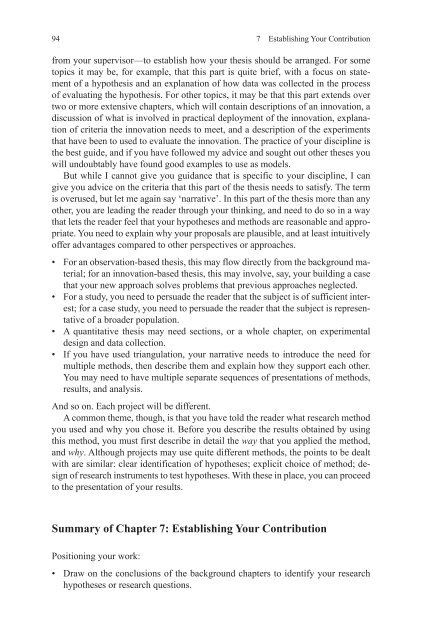How-to-Write-a-Better-Thesis
Create successful ePaper yourself
Turn your PDF publications into a flip-book with our unique Google optimized e-Paper software.
94 7 Establishing Your Contribution<br />
from your supervisor—<strong>to</strong> establish how your thesis should be arranged. For some<br />
<strong>to</strong>pics it may be, for example, that this part is quite brief, with a focus on statement<br />
of a hypothesis and an explanation of how data was collected in the process<br />
of evaluating the hypothesis. For other <strong>to</strong>pics, it may be that this part extends over<br />
two or more extensive chapters, which will contain descriptions of an innovation, a<br />
discussion of what is involved in practical deployment of the innovation, explanation<br />
of criteria the innovation needs <strong>to</strong> meet, and a description of the experiments<br />
that have been <strong>to</strong> used <strong>to</strong> evaluate the innovation. The practice of your discipline is<br />
the best guide, and if you have followed my advice and sought out other theses you<br />
will undoubtably have found good examples <strong>to</strong> use as models.<br />
But while I cannot give you guidance that is specific <strong>to</strong> your discipline, I can<br />
give you advice on the criteria that this part of the thesis needs <strong>to</strong> satisfy. The term<br />
is overused, but let me again say ‘narrative’. In this part of the thesis more than any<br />
other, you are leading the reader through your thinking, and need <strong>to</strong> do so in a way<br />
that lets the reader feel that your hypotheses and methods are reasonable and appropriate.<br />
You need <strong>to</strong> explain why your proposals are plausible, and at least intuitively<br />
offer advantages compared <strong>to</strong> other perspectives or approaches.<br />
• For an observation-based thesis, this may flow directly from the background material;<br />
for an innovation-based thesis, this may involve, say, your building a case<br />
that your new approach solves problems that previous approaches neglected.<br />
• For a study, you need <strong>to</strong> persuade the reader that the subject is of sufficient interest;<br />
for a case study, you need <strong>to</strong> persuade the reader that the subject is representative<br />
of a broader population.<br />
• A quantitative thesis may need sections, or a whole chapter, on experimental<br />
design and data collection.<br />
• If you have used triangulation, your narrative needs <strong>to</strong> introduce the need for<br />
multiple methods, then describe them and explain how they support each other.<br />
You may need <strong>to</strong> have multiple separate sequences of presentations of methods,<br />
results, and analysis.<br />
And so on. Each project will be different.<br />
A common theme, though, is that you have <strong>to</strong>ld the reader what research method<br />
you used and why you chose it. Before you describe the results obtained by using<br />
this method, you must first describe in detail the way that you applied the method,<br />
and why. Although projects may use quite different methods, the points <strong>to</strong> be dealt<br />
with are similar: clear identification of hypotheses; explicit choice of method; design<br />
of research instruments <strong>to</strong> test hypotheses. With these in place, you can proceed<br />
<strong>to</strong> the presentation of your results.<br />
Summary of Chapter 7: Establishing Your Contribution<br />
Positioning your work:<br />
• Draw on the conclusions of the background chapters <strong>to</strong> identify your research<br />
hypotheses or research questions.














![[Lonely Planet] Sri Lanka](https://img.yumpu.com/59845622/1/169x260/lonely-planet-sri-lanka.jpg?quality=85)


